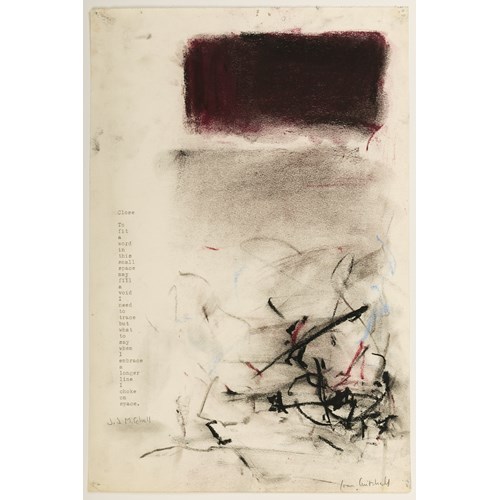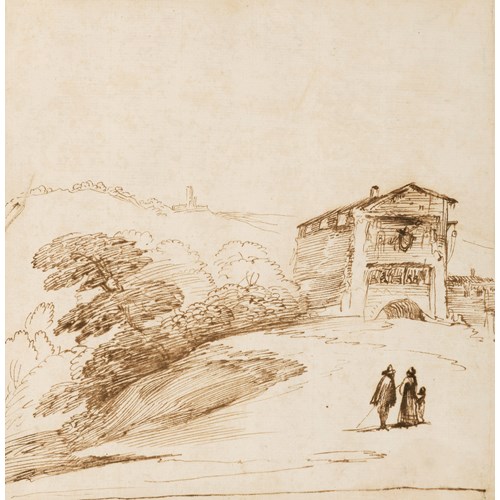Daniel LINDTMAYER
Design for a Stained-Glass Window: Saint Jerome in the Desert with the Annunciation Above, and a Kneeling Donor and a Coat of Arms Below
Date 1595
Period 16th Century
Medium Pen and black ink and grey wash
Dimension 30.5 x 20.3 cm (12 x 8 inches)
This large drawing is a particularly fine example of Lindtmayer’s drawings for stained-glass (Scheibenriss) panels, which are characterized by refined and elaborate compositions with prominent architectural elements and a vigorous handling of the pen. As noted in the artist’s inscription in a cartouche at the bottom of the sheet, the donor of the stained-glass window for which this drawing is a study, who is depicted kneeling in prayer before his patron saint at the lower left of the composition, was one Hieronymus Bor. A native of Weinfelden, in the canton of Thurgau, Bor served as pastor of a church in the town of Wollmatingen, today part of the city of Konstanz in the German province of Badem-Württembergt. At the lower right of the composition is Bor’s coat of arms which, like that of Weinfelden, incorporated bunches of grapes. The present sheet was drawn in Konstanz in 1595, the same year that the artist attacked and attempted to kill a goldsmith working in the city.
This fine drawing has a long and illustrious provenance, and has figured in several significant collections of Swiss drawings. The first owner of the drawing was the Swiss pastor Johann Wilhelm Veith (1758-1833), arguably the most important collector of his day in Schaffhausen, who published religious treatises, poems and essays on art and science. As well as paintings and prints, Veith assembled a highly significant collection of around 2,500 drawings, of which stained-glass designs made up only a relatively small part. A large number of the drawings in his collection were purchased, at the posthumous Veith sale of 1835, by the Zurich politician Dietrich Schindler (1795-1882), who collected prints and drawings by Swiss artists. Part of Schindler’s collection was exhibited in Munich in 1876, and not long afterwards his collection was acquired by the Swiss councillor Friedrich Bürki (1819-1880). Bürki had hoped to establish a Swiss national museum in Bern but died shortly after acquiring the Schindler drawings. A sale of his collection was held in Basel in 1881, and included some 450 drawings for stained-glass designs, almost all from the Veith and Schindler collections, including a folio or album containing thirty drawings by Daniel Lindtmayer. Ninety-two of the drawings from Bürki’s collection, including the present sheet, reappeared at auction in Berlin in April 1895.
This fine drawing by Lindtmayer eventually entered the collection of the lawyer and art historian Hugo von Ziegler (1890-1966), who assembled a superb group of 16th century Swiss drawings, as well as coins and silverware, between the 1920s and the 1960s. A native of Schaffhausen, von Ziegler collected in particular drawings by artists active in the city. He also organized an exhibition of drawings by Daniel Lindtmayer in Schaffhausen in 1952, to which he lent the present sheet. Other drawings of stained-glass designs from the von Ziegler collection are today in the Museum of Fine Arts in Boston, the J. Paul Getty Museum in Los Angeles, the Metropolitan Museum of Art in New York and the Museum zu Allerheiligen in Schaffhausen.
Date: 1595
Period: 16th Century
Medium: Pen and black ink and grey wash
Signature: Signed with the artist’s monogram DL at the lower right.
Inscribed and dated Hieronimus Bor von / Winfelden Pfarerr zu / Wolmatingen. 1595. in a cartouche at the bottom.
Inscribed (in a modern hand) Der bussende Hieronymus / Daniel Lindtmayer and numbered 300- on the verso.
Dimension: 30.5 x 20.3 cm (12 x 8 inches)
Provenance: Johann Wilhelm Veith, Andelfingen and Schaffhausen
His posthumous sale, Leipzig, Rudolf Weigel, 2 November 1835 onwards, probably lot 538 (‘Lindmeier, Daniel…Der heil. Hieronymus von dem Crucifix betend, mit reicher Einfass. Feder u. Tusche’), or else possibly part of lot 1051 (‘Eine Sammlung von 258 Bl. Wappen vielfältig mit reichen hist. u. sinnbildl. Umgebungen u. Scenen des lebens von Künstlern d. 16. Jahrh. als Joh. Rud. Fuesli, H. u. W. Kübler, L. Ringler, H. C. Lang, D. Lindmeier, Chr. Maurer, T. Stimmer u. andern. Mit der Feder in Tusche, mehrere in Farben ausgeführt u. jedes Blatt auf starke weisse Pappe aufgebracht. Meist. roy. fol.’)
Dietrich Schindler, Glarus and Zurich (Lugt 793), until after 1876
Friedrich Bürki, Bern
Probably his posthumous sale, Basel, Kunsthalle [Elie Wolf], 18 June 1881 onwards, probably part of Handzeichnungen lot 5
Anonymous sale, Berlin, Amsler & Ruthardt, 24 April 1895, lot 14
An unidentified collector’s mark (Lugt 168, possibly Amsler & Ruthart or A. Rump) stamped in blue ink on the verso
A partial, unidentified circular mark, incorporating the word WIEN (not in Lugt) stamped on the verso
Possibly Paul Ganz, Basel, in the early 1920s
Dr. Hugo von Ziegler, Schaffhausen
Thence by descent.
Literature: Rudolf Weigel, Kunstsammlung des verst. Hrn. Antistes und Dekan Veith in Schaffhausen, Teil I: Holzschnitte, Originalhandzeichnungen und di Kupferstiche der deutschen Schule..., Leipzig, 1835, no.538; G. K. Nagler, Neues allgemeines Künstkler-Lexicon, vol.VII, Munich, 1839, p.539, no.6; Paul Boesch, ‘Daniel Lindtmayers Scheibenriß für Pfarrer Hieronymus Bor von Weinfelden 1595’, Weinfelder Heimatblätter, 26 May 1952, pp.301-302; Hugo von Ziegler, Daniel Lindtmayer 1552-1606: Handzeichnungen, exhibition catalogue, Schaffhausen, 1952, no.160; Friedrich Thöne,Zeichnungssammlung Dr. Hugo von Ziegler, Schaffhausen, unpublished MS, 1968, no.78; Friedrich Thöne, Daniel Lindtmayer, 1552-1606/07: Die Schaffhauser Künstlerfamilie Lindtmayer, Zürich and Munich, 1975, p.64, p.109, p.218, no.289, fig.349 and p.217, under no.284.
Exhibition: Schaffhausen, Museum zu Allerheiligen, Tobias Stimmer 1539-1584: Gedächtnisaustellung zum 400. Geburtsjahr, 1939, no.207; Schaffhausen, Museum zu Allerheiligen, Daniel Lindtmayer 1552-1606:Handzeichnungen, 1952, no.160.
More artworks from the Gallery






_T638203653957560297.jpg?width=500&height=500&mode=pad&scale=both&qlt=90&format=jpg)


